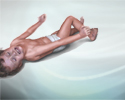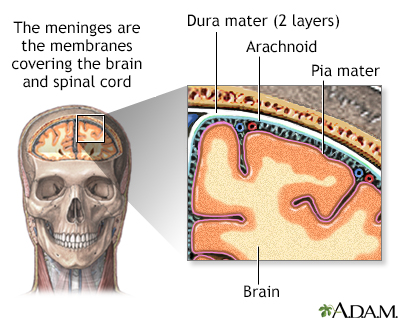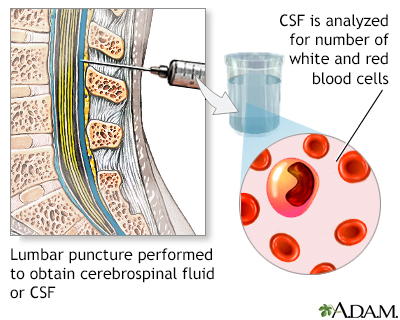Pneumococcal meningitis
Meningitis is an infection of the membranes covering the brain and spinal cord. This covering is called the meninges.
Meningitis
Meningitis is an infection of the membranes covering the brain and spinal cord. This covering is called the meninges.

Bacteria are one type of germ that can cause meningitis. The pneumococcal bacteria are one kind of bacteria that causes meningitis.
Causes
Pneumococcal meningitis is caused by Streptococcus pneumoniae bacteria (also called pneumococcus, or S pneumoniae). This type of bacteria is the most common cause of bacterial meningitis in adults. It is the second most common cause of meningitis in children older than age 2.
Risk factors include:
- Alcohol use
- Diabetes
Diabetes
Diabetes is a long-term (chronic) disease in which the body cannot regulate the amount of sugar in the blood.
 ImageRead Article Now Book Mark Article
ImageRead Article Now Book Mark Article - History of meningitis
- Infection of a heart valve with S pneumoniae
- Injury or trauma to the head
- Meningitis in which there is leakage of spinal fluid
- Recent ear infection with S pneumoniae
- Recent pneumonia with S pneumoniae
Pneumonia
Pneumonia is inflamed or swollen lung tissue due to infection with a germ. This article covers community-acquired pneumonia (CAP). This type of pneu...
 ImageRead Article Now Book Mark Article
ImageRead Article Now Book Mark Article - Recent upper respiratory infection
Upper respiratory infection
The common cold most often causes a runny nose, nasal congestion, and sneezing. You may also have a sore throat, cough, headache, or other symptoms....
 ImageRead Article Now Book Mark Article
ImageRead Article Now Book Mark Article - Spleen removal or a spleen that does not function
Symptoms
Symptoms usually come on quickly, and may include:
- Fever and chills
- Mental status changes
Mental status changes
Confusion is the inability to think as clearly or quickly as you normally do. You may feel disoriented and have difficulty paying attention, remembe...
 ImageRead Article Now Book Mark Article
ImageRead Article Now Book Mark Article - Nausea and vomiting
- Sensitivity to light (photophobia)
- Severe headache
- Stiff neck
Other symptoms that can occur with this disease:
- Agitation
- Bulging fontanelles in infants
Bulging fontanelles
A bulging fontanelle is an outward curving of an infant's soft spot (fontanelle).
 ImageRead Article Now Book Mark Article
ImageRead Article Now Book Mark Article - Decreased consciousness
- Poor feeding or irritability in children
- Rapid breathing
Rapid breathing
Hyperventilation is rapid and deep breathing. It is also called overbreathing, and it may leave you feeling breathless.
 ImageRead Article Now Book Mark Article
ImageRead Article Now Book Mark Article - Unusual posture, with the head and neck arched backwards (opisthotonos)
Opisthotonos
Opisthotonos is a condition in which a person holds their body in an abnormal position. The person is usually rigid and arches their back, with thei...
 ImageRead Article Now Book Mark Article
ImageRead Article Now Book Mark Article
Pneumococcal meningitis is an important cause of fever in infants.
Exams and Tests
Your health care provider will perform a physical exam. Questions will focus on symptoms and possible exposure to someone who might have the same symptoms, such as a stiff neck and fever.
If your provider thinks meningitis is possible, a lumbar puncture (spinal tap) will likely be done. This is to obtain a sample of spinal fluid for testing.
Spinal tap
Cerebrospinal fluid (CSF) collection is a test to look at the fluid that surrounds the brain and spinal cord. CSF acts as a cushion, protecting the b...

Other tests that may be done include:
- Blood culture
Blood culture
A blood culture is a laboratory test to check for bacteria or other germs in a blood sample.
 ImageRead Article Now Book Mark Article
ImageRead Article Now Book Mark Article - Chest x-ray
Chest x-ray
A chest x-ray is an x-ray of the chest, lungs, heart, large arteries, ribs, and diaphragm.
 ImageRead Article Now Book Mark Article
ImageRead Article Now Book Mark Article - CT scan of the head
CT scan of the head
A head computed tomography (CT) scan uses many x-rays to create pictures of the head, including the skull, brain, eye sockets, and sinuses.
 ImageRead Article Now Book Mark Article
ImageRead Article Now Book Mark Article - Complete blood count (CBC)
Complete blood count
A complete blood count (CBC) test measures the following:The number of white blood cells (WBC count)The number of red blood cells (RBC count)The numb...
 ImageRead Article Now Book Mark Article
ImageRead Article Now Book Mark Article - Gram stain or other special stains, and culture of the spinal fluid
Gram stain
A Gram stain is a test used to identify bacteria. It is one of the most common ways to quickly diagnose bacterial infection in the body.
 ImageRead Article Now Book Mark Article
ImageRead Article Now Book Mark ArticleCulture of the spinal fluid
A cerebrospinal fluid (CSF) culture is a lab test to look for bacteria, fungi, and viruses in the fluid that moves in the space around the spinal cor...
 ImageRead Article Now Book Mark Article
ImageRead Article Now Book Mark Article
Treatment
Antibiotics will be started as soon as possible. Ceftriaxone is one of the most commonly used antibiotics.
If the antibiotic is not working and your provider suspects antibiotic resistance, vancomycin or rifampin may be used. Sometimes, corticosteroids are also used.
Outlook (Prognosis)
Meningitis is a dangerous infection and it can be deadly. The sooner it is treated, the better your chance for recovery. Young children and adults over age 50 have the highest risk for death.
Possible Complications
Long-term complications may include:
- Brain damage
- Buildup of fluid between the skull and brain (subdural effusion)
Subdural effusion
A subdural effusion is a collection of cerebrospinal fluid (CSF) trapped between the surface of the brain and the outer lining of the brain (the dura...
Read Article Now Book Mark Article - Buildup of fluid inside the skull that leads to brain swelling (hydrocephalus)
Hydrocephalus
Hydrocephalus is a buildup of fluid inside the skull that leads to the brain pushing against the skull. Hydrocephalus means "water on the brain. "...
 ImageRead Article Now Book Mark Article
ImageRead Article Now Book Mark Article - Hearing loss
- Seizures
Seizures
A seizure is the physical changes in behavior that occurs during an episode of specific types of abnormal electrical activity in the brain. The term ...
 ImageRead Article Now Book Mark Article
ImageRead Article Now Book Mark Article
When to Contact a Medical Professional
Call 911 or the local emergency number or go to an emergency room if you suspect meningitis in a young child who has the following symptoms:
- Feeding problems
- High-pitched cry
- Irritability
- Persistent unexplained fever
Meningitis can quickly become a life-threatening illness.
Prevention
Early treatment of pneumonia and ear infections caused by pneumococcus may decrease the risk of meningitis. There are also two effective vaccines available to prevent pneumococcus infection:
- Pneumococcal polysaccharide vaccine (PPSV23)
Pneumococcal polysaccharide vaccine (PP...
All content below is taken in its entirety from the CDC Pneumococcal Polysaccharide Vaccine Information Statement (VIS): CDC review information for P...
 ImageRead Article Now Book Mark Article
ImageRead Article Now Book Mark Article - Pneumococcal conjugate vaccine
Pneumococcal conjugate vaccine
Content below is taken in its entirety from the CDC Information Statement (VIS): www. cdc. gov/vaccines/hcp/current-vis/pneumococcal-conjugate. html...
 ImageRead Article Now Book Mark Article
ImageRead Article Now Book Mark Article
The following people should be vaccinated, according to current recommendations:
- Children
- Adults age 65 and older
- People at high risk for pneumococcus infection
Reviewed By
Jatin M. Vyas, MD, PhD, Professor in Medicine, Harvard Medical School; Associate in Medicine, Division of Infectious Disease, Department of Medicine, Massachusetts General Hospital, Boston, MA. Also reviewed by David C. Dugdale, MD, Medical Director, Brenda Conaway, Editorial Director, and the A.D.A.M. Editorial team.
Centers for Disease Control and Prevention website. Meningitis. About bacterial meningitis. www.cdc.gov/meningitis/about/bacterial-meningitis.html. Updated January 9, 2024. Accessed September 3, 2024.
Hasbun R, Van de Beek D, Brouwer MC, Tunkel AR. Acute meningitis. In: Bennett JE, Dolin R, Blaser MJ, eds. Mandell, Douglas, and Bennett's Principles and Practice of Infectious Diseases. 9th ed. Philadelphia, PA: Elsevier; 2020:chap 87.
Nath A. Meningitis: bacterial, viral, and other. In: Goldman L, Cooney KA, eds. Goldman-Cecil Medicine. 27th ed. Philadelphia, PA: Elsevier; 2024:chap 381.
Ramirez KA, Peters TR. Streptococcus pneumoniae (pneumococcus). In: Kliegman RM, St. Geme JW, Blum NJ, et al, eds. Nelson Textbook of Pediatrics. 22nd ed. Philadelphia, PA: Elsevier; 2025:chap 228.





 All rights reserved.
All rights reserved.